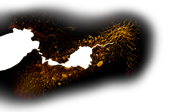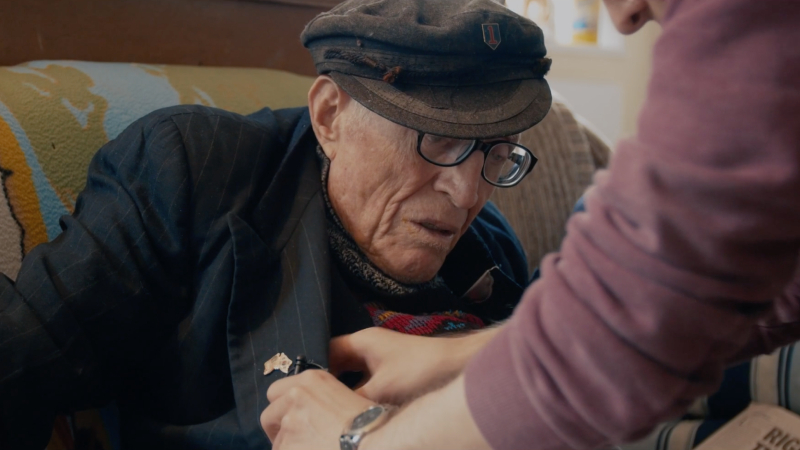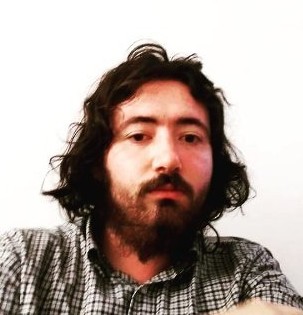




Elan Golod is an Israeli-American filmmaker and editor. He studied at New York University’s Tisch School of the Arts. He directed his debut feature Nathan-ism in 2023. This documentary of admirable beauty registers Nathan Hilu, a retired Jewish guard as he recalls his experiences of Nazi Germany through his cartoon work. Our writer Eoghan Lyng (who wrote the film review) prepared a few questions for the nascent and promising documentarist:
…
.
Eoghan Lyng – What was it that drew you to Nathan Hilu; the man or the story?
Elan Golod – In Nathan’s case it’s difficult to separate the man from the story as they are so intertwined. I had come across an article about an exhibition of Hilu’s work, and I was immediately captivated by the complexity of his journey – A young Jewish man confronted with the perpetrators of the Holocaust, the details of which he was learning about in real time as the Nuremberg trials were unfolding. I was also intrigued by the cognitive dissonance in his artwork, which depicts heavy subject matter in a very colorful, childlike style. This unique blend felt inherently cinematic and offered a fresh way of telling a story related to the Holocaust.
EL – One of the strengths of the film is the archive of footage from 1945. How did you come across the memorabilia?
EG – I spent many hours digging through numerous online archives, searching for archival imagery that had not been used in previous Holocaust documentaries. Unfortunately the repetition of the same archival footage in many films about the Holocaust can desensitise the audience and I wanted to avoid that as much as possible.
EL – When did Hilu discover an interest in comic drawing, and do you think it was therapeutic for him?
EG – Unfortunately, it’s difficult to nail down exactly when Nathan’s artistic work began as he never dated his work. Though in interviews he often made references to the fact that he was drawing from a young age, even prior to his military service. I think even Nathan was keenly aware that his artwork had a therapeutic effect for him, helping him process the complexity of his memories. Though never formally diagnosed, I believe it’s likely Nathan grappled with PTSD from his time in Nuremberg and his creation of a visual memoir was an essential outlet for him.
EL – How long did it take to complete the film, and were there any major challenges faced along the way?
EG – The journey of making this film took approximately eight years – I got to film the last four years of Nathan’s life and then spent several years unpacking and untangling the countless stories Nathan told me to craft the narrative of the film in the edit.
While Nathan’s charismatic persona enriched the narrative, it also presented challenges in the filmmaking process. Our filming sessions were not typical interviews but resembled more of a “show-and-tell” experience, where Nathan enthusiastically unveiled the stories behind his latest drawings allowing minimal space for probing questions. However, by selectively highlighting certain drawings for discussion, I managed to guide the dialogue towards the specific themes I aimed to explore.

EL – The Zone of Interest (Jonathan Glazer, 2023) shows a different perspective to the Holocaust. Is it important to show every facet from the time?
EG – I think it’s commendable when filmmakers or artists in other mediums are able to expand the conversation about the Holocaust, shedding light on untold narratives and offering fresh perspectives. In exploring lesser-known stories and viewpoints, these creators challenge prevailing narratives and broaden our collective consciousness. Their work serves as a potent reminder that the Holocaust was not a monolithic event but a complex tapestry of individual experiences, each deserving of recognition and remembrance. Works like The Zone of Interest compel audiences to confront uncomfortable truths and grapple with the complexities of human nature, thereby fostering empathy, understanding, and a commitment to preventing such atrocities from recurring.
EL – It surprised me that Hilu called Albert Speer a “friendly guy.” Were you taken aback by that revelation?
EG – This was quite the surprise to me as well, but the more I got to know Nathan the more it seemed to make sense. Confronted with such evil among the defendants he was guarding, I think Nathan was trying to grasp onto some semblance of humanity among this group of prisoners and Albert Speer emerged as the closest embodiment of that. Several other former guards at the Nuremberg trials commented on how personable Albert Speer was compared to the rest of the Nazi defendants they guarded in the prison.
EL – Hilu intimates that art prevented him from getting dementia – do you think that’s a fair comment?
EG – To some degree, that’s very possible. Art therapy is often seen as a promising intervention that could potentially mitigate the progression of cognitive decline. However, it’s important to acknowledge the complex nature of memory. While Nathan may have believed that his artwork was effectively preserving his memories, the reality might be more nuanced. Memories can be elusive and subject to distortion over time, challenging the notion that any intervention can fully preserve them intact.
EL – You screened the film in Israel: what was the reaction to it?
EG – The film was extremely well received in Israel and Nathan’s story was particularly resonant for a primarily Jewish audience in Israel. Having grown up in Israel, our screenings in Tel Aviv and Jerusalem were particularly poignant for me. My team and I were extremely honored to receive an award from Yad Vashem (The World Holocaust Remembrance Center) for “cinematic excellence in Holocaust documentary filmmaking”. The film will have its broadcast release in Israel on the Holocaust Remembrance Day (Yom HaShoah) on May 5th of this year.
EL – Talk to us about the animation process: was that difficult to realise for the big screen?
EG – From the outset I felt strongly that Nathan’s vibrant artwork could be brought to life through animation. However, the main challenge was finding the right animator who could emulate Hilu’s style authentically. A few years into the filmmaking process, I came across the work of Héloïse Dorsan Rachet, a Paris-based animator who had done beautiful animation sequences for Michelle Steinberg’s documentary “A Place to Breathe.” Her work left me with the impression that she could replicate Nathan’s hand-drawn style. I supplied Héloïse with numerous references from Nathan’s artwork and we set out on a series of tests to figure out how to bring Nathan’s work to life while staying as true to the original work. The specific references we chose and the animation treatment we landed on ended up being crucial in immersing viewers in Nathan’s deeply subjective perspective.
EL – Do you think it’s important to note down these memories of WW2 on screen, and what do you think audiences will learn from this film?
EG – I think that especially at this pivotal moment when the last living witnesses from the WWII era are passing away, it is essential to discuss the challenges in stewarding history for the next generation. I recently had the honour of bringing the film and Nathan’s story full circle by screening the film inside Courtroom 600 in Nuremberg, where the Nazi criminals were brought to justice. This momentous occasion served as a poignant reminder of the weighty responsibility we bear in safeguarding our collective memory. I hope viewers take this film as an opportunity to examine the ways in which we can keep our stories alive, and the intrinsic value of taking the time to listen to our elders.
EL – The film makes very little reference to the conflict with Palestine. Please comment.
EG – The film was made and released long before the current situation unfolded, therefore it does not reference the conflict. During my time with Nathan, he never really brought up Israeli-Palestinian conflict as a subject of discussion or drawing, so my team and I did not feel the impulse to insert it into the film’s narrative.
…
.
Elan Golod is pictured at the top of this interview. The other image is a production still of Nathan-ism.
















